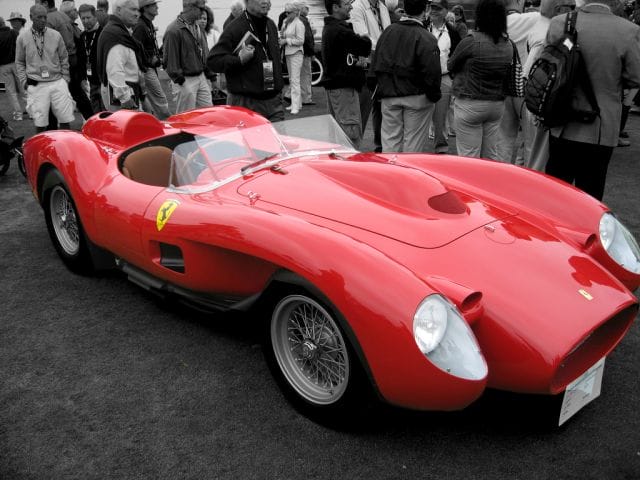
Via Simon Davidson (Flickr)
![]()
In September 2014, on a provincial farm somewhere in the West of France, two men opened the rusty doors to their deceased grandfather’s barn. Inside sat a treasure trove: dozens of collectible cars — Bugattis, Ferraris, Porsches, Jaguars, Maseratis — some dating back nearly a century.
Not knowing exactly what they were looking at, the men called upon Artcurial, a French auction house, to appraise the find.
“When we discovered the extent of the collection we found ourselves overcome with emotion,” one of the auctioneers later said. “Probably much like…the first person for centuries to enter Tut’s tomb. It really was a case of waking up sleeping beauty.”
Eventually, the 59 cars, in various states of disrepair, would go on to sell for a total of $28.5 million at auction. The crown jewel of these, a 1961 Ferrari 250 GT, demanded an astounding $18.5 million.
In recent years, the wealth gap between America’s top earners and the rest of the country has reached its widest point in three decades; as a result, demand for luxury goods has increased, and top-of-the-line, vintage “blue chip” cars have skyrocketed in value. The most lucrative and sought after of these cars have outperformed the S&P 500, NASDAQ, and gold. In the collectibles market, they are heads and shoulders above the competition:
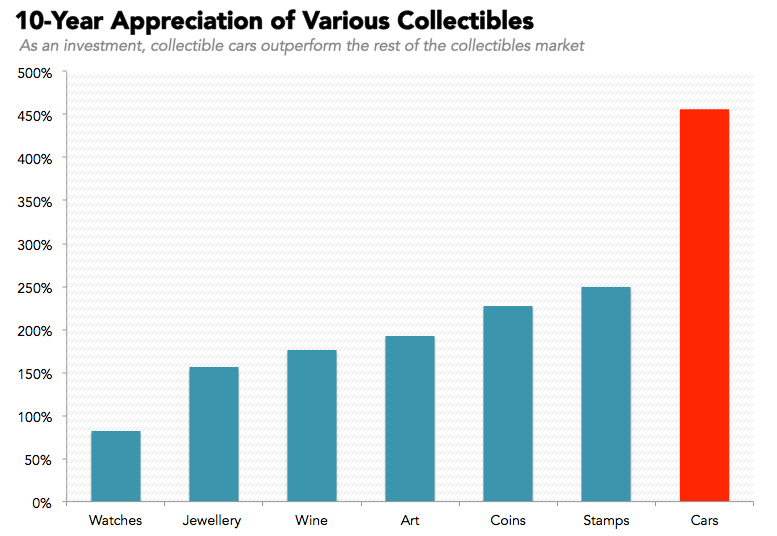
Zachary Crockett, Priceonomics; Data via The Wealth Report
Obviously, not every collectible car is valued equally: of the thousands of vintage cars listed for auction every year, only about 3% — the “best of the best” — are successfully sold.
We were curious how much these top-of-the-line collectibles sell for, and which brands typically appreciate most. So, as dutiful data miners, we dove into the numbers.
First, we began with a public list of cars auctioned for more than $7 million. We then expanded on this list using data from various auction houses that specialize in and/or frequently feature high-end car sales (Kruse International, Christie’s, RM Auctions, Artcurial, Bonhams, Barrett-Jackson, Gooding & Company, and Sotheby’s). This data does not include private sales (which are much harder to track and verify), nor does it include the sale of brand new cars (though the most expensive car on the market, the Lamborghini Veneno Roadster, wouldn’t even make this list anyway).
Dollar amounts here represent the purchase price plus the standard auction fee (about 2.5%), and all are adjusted for inflation and represented in 2015 dollars.
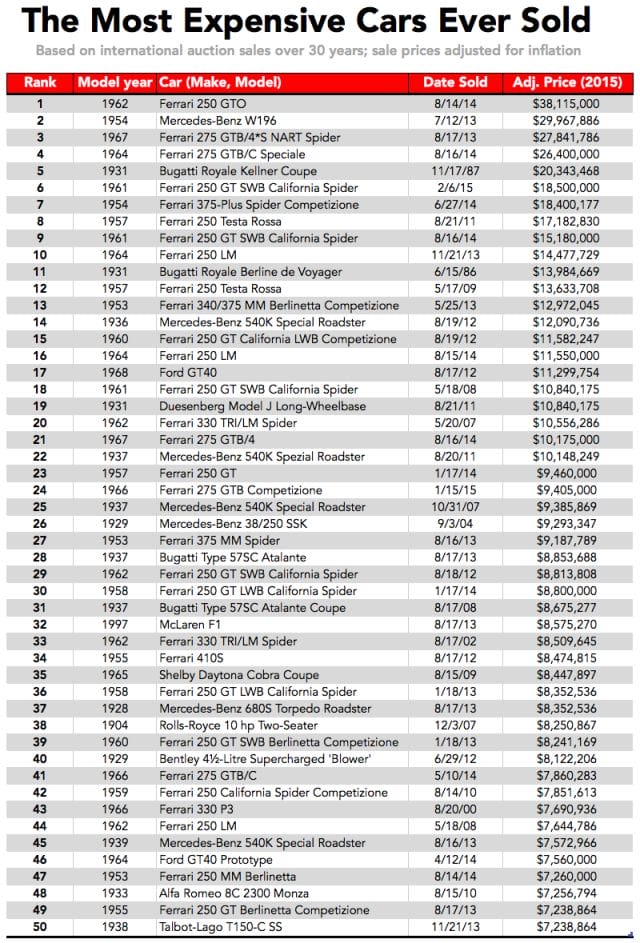
Zachary Crockett, Priceonomics; Data via Wikipedia, various auction houses (Kruse International, Christie’s, RM Auctions, Artcurial, Bonhams, Barrett-Jackson, Gooding & Company, and Sotheby’s)
The most expensive car ever sold at auction, a Ferrari 250 GTO, went for $38.15 million in August of 2014. One of only 39 Ferrari GTOs ever produced, this one came with quite a backstory, including a legendary racing history, a fatal crash, and an extensive restoration.
Of the 50 most expensive cars ever sold at auction, 30 are Ferraris. All 30 were made between the years 1953 and 1967, and the vast majority (18) are part of Ferrari’s ‘250’ series.
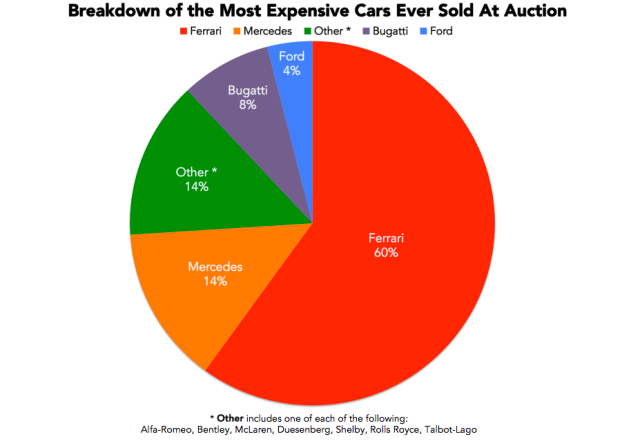
Zachary Crockett, Priceonomics; Data via Wikipedia, various auction houses
The dominance of Ferrari cars here speaks to a larger trend in the collector car industry.
According to the Hagerty Collector Car Index, which tracks the value of various collector cars, the majority of the market has stagnated. While German (BMW, Porsche, Mercedes-Benz), British (Bentley, Rolls Royce), and American (Ford GT) cars have stagnated, Ferraris have skyrocketed. In the last five years, the average “excellent” condition, vintage Ferrari to hit the auction block has nearly tripled in value:
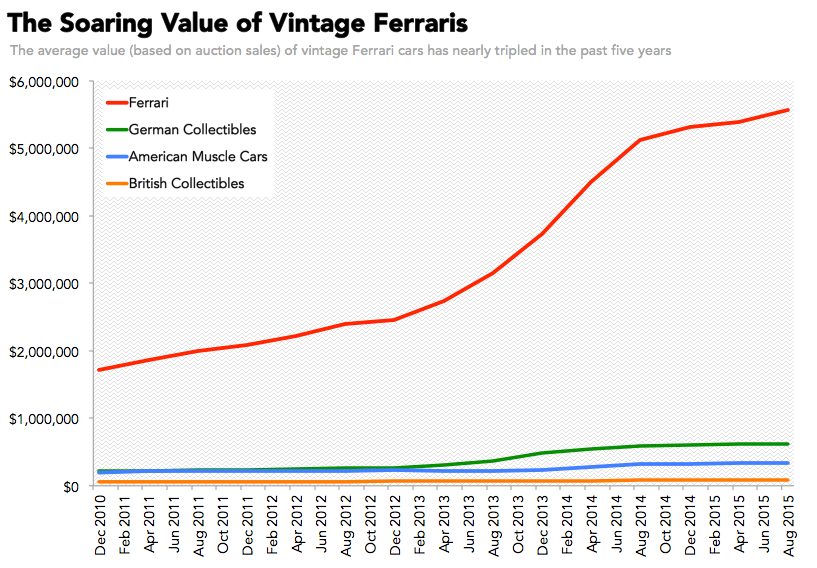
Zachary Crockett; Data via the Hagerty Collector Car Index
But why are Ferraris so dominant in the collector car market?
The value of a collector car is based on a wide range of criteria: desirability, rarity, production volume, demand, aesthetics, generational nostalgia, condition, originality, and a car’s backstory/previous ownership all play a role. Ferraris, in particular, meet these requirements.
First of all, Ferrari has consistently been deemed “the world’s most powerful” car brand by marketing firms, largely based on the fact that it has maintained a very low production, despite rising demand.
“One of the fundamental values of Ferrari is its exclusivity,” Edgar Baum, a brand valuation consultant, told Luxury Daily. “One of the challenges they face as an organization is that there is a push from more people to buy and they have a very loyal customer base that keeps coming back to them.”
The dominance of Ferraris on this list can be attributed, in part, to this exclusivity. For instance, the most expensive sold ever sold at auction, the Ferrari 250 GTO, was only one of 39 ever produced. Originally selling for £6,000 (US$9,000), the 250 GTO has increased more than 500,000% in value since 1961.
Ferraris also dominated track and road racing throughout the 1960s, lending a legendary flair to many of the vintage cars’ backstories. A 1953 Ferrari 340/375, ranked 13th on our list, was raced by three world champions; others, like the 375-plus (7th) competed favorably in the 24 Heures du Mans.
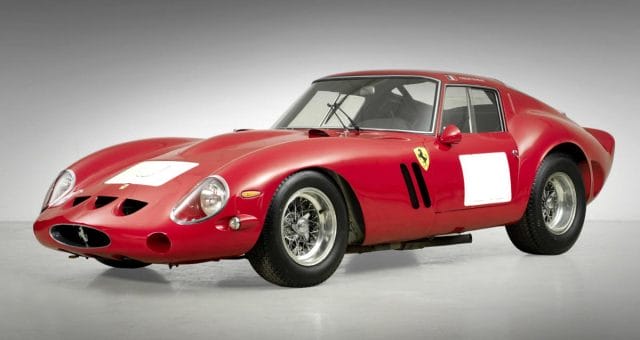
The record-setting $38 million 1962 Ferrari 250 GTO; via Bonhams
It’s important to keep in mind, though, that the cars on this list are the best of the best: 97% of all vintage cars on the auction block fail to sell above asking price — and the vast majority of them go for significantly less than $1 million.
And while these top-notch cars might be lucrative as an investment, they are pointless to the utilitarians among us.
A 1962 Ferrari GTO goes from 0 to 60 miles-per-hour in about 6 seconds and has a top speed of 158. “Today’s sportiest Ford Focus,” writes Bloomberg, “puts out similar numbers with eight fewer cylinders, a bunch more airbags, and a back-up camera to boot.”
The difference: one costs $38 million, and the other $36,000.
![]()
Our next post explores the statistical dominance of Dr. Seuss in children’s literature.
To get notified when we post it → join our email list.
![]()
This post was written by Zachary Crockett. You can follow him on Twitter at @zzcrockett



